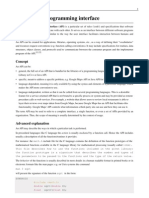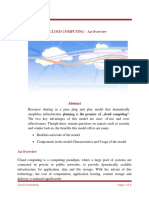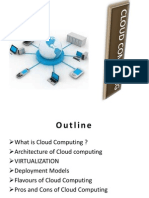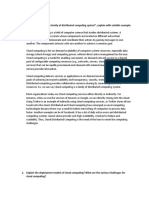0 ratings0% found this document useful (0 votes)
62 viewsCloud 3
Cloud 3
Uploaded by
JohnUnit 3 covers cloud computing architecture including the introduction, reference model, types of clouds, economics, and open challenges. It defines cloud computing and outlines 5 essential characteristics and 3 service models. The types of clouds covered are public, private, hybrid, and community clouds. The economics of cloud computing focus on the financial benefits of the pay-as-you-go model in reducing costs. Open challenges discussed include achieving a common definition and standards for interoperability, ensuring scalability and fault tolerance, and addressing security, trust, privacy, and organizational aspects in cloud adoption.
Copyright:
© All Rights Reserved
Available Formats
Download as PDF, TXT or read online from Scribd
Cloud 3
Cloud 3
Uploaded by
John0 ratings0% found this document useful (0 votes)
62 views28 pagesUnit 3 covers cloud computing architecture including the introduction, reference model, types of clouds, economics, and open challenges. It defines cloud computing and outlines 5 essential characteristics and 3 service models. The types of clouds covered are public, private, hybrid, and community clouds. The economics of cloud computing focus on the financial benefits of the pay-as-you-go model in reducing costs. Open challenges discussed include achieving a common definition and standards for interoperability, ensuring scalability and fault tolerance, and addressing security, trust, privacy, and organizational aspects in cloud adoption.
Original Description:
Copyright
© © All Rights Reserved
Available Formats
PDF, TXT or read online from Scribd
Share this document
Did you find this document useful?
Is this content inappropriate?
Unit 3 covers cloud computing architecture including the introduction, reference model, types of clouds, economics, and open challenges. It defines cloud computing and outlines 5 essential characteristics and 3 service models. The types of clouds covered are public, private, hybrid, and community clouds. The economics of cloud computing focus on the financial benefits of the pay-as-you-go model in reducing costs. Open challenges discussed include achieving a common definition and standards for interoperability, ensuring scalability and fault tolerance, and addressing security, trust, privacy, and organizational aspects in cloud adoption.
Copyright:
© All Rights Reserved
Available Formats
Download as PDF, TXT or read online from Scribd
Download as pdf or txt
0 ratings0% found this document useful (0 votes)
62 views28 pagesCloud 3
Cloud 3
Uploaded by
JohnUnit 3 covers cloud computing architecture including the introduction, reference model, types of clouds, economics, and open challenges. It defines cloud computing and outlines 5 essential characteristics and 3 service models. The types of clouds covered are public, private, hybrid, and community clouds. The economics of cloud computing focus on the financial benefits of the pay-as-you-go model in reducing costs. Open challenges discussed include achieving a common definition and standards for interoperability, ensuring scalability and fault tolerance, and addressing security, trust, privacy, and organizational aspects in cloud adoption.
Copyright:
© All Rights Reserved
Available Formats
Download as PDF, TXT or read online from Scribd
Download as pdf or txt
You are on page 1of 28
Unit 3
• Cloud Computing Architecture :
• Introduction
• Cloud Reference Model
• Types of Clouds
• Economics of the Cloud
• Open Challenges.
• Definition.
“Cloud computing is a utility-oriented and
internet centric way of delivering IT services
on demand. These services cover the entire
computing stack : from the hardware
infrastructure packaged as a set of virtual
machines to software services such as
development platforms and distributed
applications. “
• 5 essential characteristics :
1. In demand self service
2. Broad network access
3. Resource pooling
4. Rapid elasticity
5. Measured service
• 3 service models
1. Software-as-a-Service (SaaS)
2. Platform-as-a-Service(PaaS)
3. Infrastructure-as-a-Service(IaaS)
• 4 deployment models
1. Public clouds
2. Private clouds
3. Community clouds
4. Hybrid clouds
• Cloud reference model.
• IaaS
- provides virtualized computing resources over the
internet.
- A cloud provider hosts the infrastructure
components present in an on-premises data
center, including servers, storage and networking
hardware.
- provider also supplies services like billing,
monitoring, log access, security, load balancing,
clustering, backups, replication and recovery.
• PaaS
- is a third-party provider delivers hardware and
software tools needed for application
development over the internet.
- Allows to avoid the expense and complexity of
buying and managing software licenses .
• SaaS
- is a software distribution model in which a
third-party provider hosts applications and makes
them available to customers over the Internet.
- SaaS removes the need for organizations to install
and run applications on their own computers or in
their own data centers. This eliminates the
expense of hardware acquisition, provisioning and
maintenance, as well as software licensing,
installation and support.
• Types of clouds
1. Public
2. Private
3. Hybrid/hetrogeneous
4. Community
• Public cloud
- is defined as computing services offered by third-party providers over
the public Internet, making them available to anyone who wants to use or
purchase them. They may be free or sold on-demand, allowing customers
to pay only per usage.
- It can save companies from the expensive costs of having to purchase,
manage and maintain on-premises hardware and application .
- A fundamental characteristic of public cloud is multi-tenancy. A public
cloud is meant to serve a multitude of users and not a single customer.
- A public cloud can offer any kind of service : infrastructure, platform, or
applications.
- For example, amazon EC2 is a public cloud providing IaaS, Google
AppEngine is a public cloud providing an application development PaaS,
and Salesforce.com is a public cloud providing SaaS.
• Private clouds
- Cloud environments dedicated to the end user, usually within the user's
firewall.
- Although private clouds ran on-premise, organizations are now
building private clouds on rented, vendor-owned data centers located
off-premise.
- Private clouds are virtual distributed systems that relay on a private
infrastructure and provide internal users with dynamic provisioning of
computing resources.
- Different from public clouds , instead of a pay-as-you-go model, there
could be other schemes which take into account the usage of the cloud.
- Another interesting opportunity that comes with private clouds is the
possibility of testing applications and systems at a comparatively lower
price rather than public cloud before deploying them .
• Hybrid clouds
- It is a mix of on-premises, private cloud and
third-party, public cloud services with
orchestration between the two platforms.
- A computing environment that combines a
public cloud and a private cloud by allowing
data and applications to be shared between
them.
• Community cloud
- Is a cloud service model that provides
a cloud computing solution to a limited number of
individuals or organizations that is governed, managed
and secured commonly by all the participating
organizations or a third party managed service
provider.
- Candidate sectors for community clouds are
media industry, healthcare industry, energy and other
core industry, public sector, scientific research,
openness, community, graceful failures, convenience
and control, environmental sustainability.
Economics of the cloud
- economics of cloud computing deal with the knowledge
concerning the principles, costs, and benefits
of cloud computing.
- The biggest benefit is financial, the pay-as-you-go model.
- Its reduces the capital cost associated to IT infrastructure.
- Eliminates the depreciation associated with IT assets.
- Replacing software licensing with subscriptions.
- Cutting down the maintenance and administrative costs of
IT resources.
- Three different strategies or pricing models of cloud
computing is
(a). Tiered pricing- services are offered in several tiers,
and each tier offers a fixed computing specification
and SLA at a specific price per unit of time.
(b). Per unit pricing- this model is suitable in cases where
the principal source of revenue for the cloud provider
is determined in terms of units of specific services.
(c). Subscription based pricing- this is the model used
mostly by SaaS providers in which users are paying a
periodic subscription fee for the usage of the software
.
Open challenges
1. Cloud definition
NIST – it characterizes cloud computing as :
on-demand self-service, broad network access,
resource pooling, rapid elasticity and measured
service.
- classifies services as SaaS, PaaS, and IaaS.
- categorizes deployment models as public,
private, community and hybrid clouds.
2. Cloud interoperability and standards.
There was no common agreement on the
protocols and technologies used but organizations
such as Cloud Computing Interoperability Form
(CCIF), Open cloud consortium and DMTF cloud
standards incubator are leading the path.
The Open Virtualization Format (OVF) is an
attempt to provide common format for virtual
machine image.
3. Scalability and fault tolerance.
The ability to scale on demand is the most attractive
feature.
The ability to tolerate failure is more important.
4. Security , Trust and privacy
These are major obstacles.
the traditional cryptographic technologies are used to
prevent data tampering .
The challenges within this area are concerned in
devising secure and trustable system from different
perspectives : technical, social and legal.
5. Organizational aspects
what is the new role of the IT department when
the company completely relies on cloud ?
How compliance department will perform its
activity when there is a considerable lack of
control over application workflows ?
What are the implications for organizations that lose
control over some aspects of their services ?
You might also like
- Rolling in Rhythm Wilcoxon PDF: Direct Link #1Document2 pagesRolling in Rhythm Wilcoxon PDF: Direct Link #1Sandro Rivera Javier0% (1)
- Cloud Computing All Units PDFDocument110 pagesCloud Computing All Units PDFRahul Gudla100% (1)
- Application Programming Interface (API)Document8 pagesApplication Programming Interface (API)alaxyad100% (1)
- Define CloudDocument31 pagesDefine CloudSukhjinder KaurNo ratings yet
- AI Unit 1Document29 pagesAI Unit 1himanshujoshi7789No ratings yet
- Unit IiiDocument27 pagesUnit Iiiyashghorpade941No ratings yet
- Cloud Security Unit - 1Document12 pagesCloud Security Unit - 1234 Satwik reddyNo ratings yet
- CC Unit-3Document6 pagesCC Unit-3praveensrikar143No ratings yet
- CC Lab 1 Roll No. 10Document15 pagesCC Lab 1 Roll No. 10Revathi DusaNo ratings yet
- CC Unit 1 Chapter1Document30 pagesCC Unit 1 Chapter1Praveena GNo ratings yet
- Oracle Cloud Computing WhitePaperDocument22 pagesOracle Cloud Computing WhitePaperDanno NNo ratings yet
- Unit-1 Part-2Document19 pagesUnit-1 Part-2suarchod deveshNo ratings yet
- Unit-Ii CCDocument51 pagesUnit-Ii CCpreethiNo ratings yet
- 05 - Ch1 Cloud Computing - Intro2 UpdatedDocument21 pages05 - Ch1 Cloud Computing - Intro2 UpdatedOmarallasasmhNo ratings yet
- Cloud Computing An OverviewDocument4 pagesCloud Computing An Overviewgurudatt.kulkarniNo ratings yet
- International Journal of Engineering Research and Development (IJERD)Document7 pagesInternational Journal of Engineering Research and Development (IJERD)IJERDNo ratings yet
- Coaching Class NotesDocument24 pagesCoaching Class NotesSamuel ShifasNo ratings yet
- Cloud Computing NotesDocument266 pagesCloud Computing NotesSusmitNo ratings yet
- Clouds: What's New Is Old Is New : Joseph Alhadeff, VP Global Public Policy CPO, OracleDocument18 pagesClouds: What's New Is Old Is New : Joseph Alhadeff, VP Global Public Policy CPO, OracleAniket NimonkarNo ratings yet
- Prof - Islam Overview of Cloud ComputingDocument32 pagesProf - Islam Overview of Cloud ComputingAdi Juliawan PawanaNo ratings yet
- Cloud Computing ReportDocument11 pagesCloud Computing ReportfebycvNo ratings yet
- CC NotesDocument88 pagesCC Notes8816 Gautam ManuelNo ratings yet
- Unit 5 Cloud Computing Overview RKSDocument22 pagesUnit 5 Cloud Computing Overview RKSmr yashNo ratings yet
- Unit 3 CC 8aiDocument19 pagesUnit 3 CC 8aiPratham WakdeNo ratings yet
- Cloud ComputingDocument17 pagesCloud ComputingkapilpjainNo ratings yet
- Cloud Computing I Unit IIDocument22 pagesCloud Computing I Unit IIjigneshahir992No ratings yet
- Cloud ComputingDocument9 pagesCloud ComputingManal FaluojiNo ratings yet
- CC Experiment 01Document6 pagesCC Experiment 01Varsha KulkarniNo ratings yet
- Cloud Deployment ModelsDocument33 pagesCloud Deployment ModelsFaiz Ul HassanNo ratings yet
- Assignment of Cloud ComputingDocument13 pagesAssignment of Cloud ComputingDrishti GuptaNo ratings yet
- Synopsis 20-09 EditedDocument43 pagesSynopsis 20-09 EditedArunvinodh ChellathuraiNo ratings yet
- CC 4Document62 pagesCC 4Mohsin AliNo ratings yet
- UNIT 1-Cloud ComputingDocument34 pagesUNIT 1-Cloud ComputingMalathyNo ratings yet
- NIST CC Reference Architecture v1 March 30 2011Document26 pagesNIST CC Reference Architecture v1 March 30 2011Arévalo José100% (1)
- Cloud Computing 2unitDocument47 pagesCloud Computing 2unit20-A0503 soumya anagandulaNo ratings yet
- Cloud Introduction: Cloud Computing Fundamentals VisionDocument31 pagesCloud Introduction: Cloud Computing Fundamentals VisionNISHADEVINo ratings yet
- Unit-1 Part-2Document20 pagesUnit-1 Part-2suarchod deveshNo ratings yet
- Cloud Computing IMR QnADocument23 pagesCloud Computing IMR QnAsumiipwraNo ratings yet
- Introduction To Cloud ComputingDocument8 pagesIntroduction To Cloud ComputingShivbhushanPandeyNo ratings yet
- CC-4 - ModDocument30 pagesCC-4 - ModMohsin AliNo ratings yet
- White Paper On Cloud ComputingDocument12 pagesWhite Paper On Cloud ComputingPravesh Kumar ThakurNo ratings yet
- Cloud Computing An IntroductionDocument39 pagesCloud Computing An Introductionsrishtityagi2020No ratings yet
- Cloud Computoing Module IDocument24 pagesCloud Computoing Module IJEEVA P GNo ratings yet
- Cloud ComputingDocument30 pagesCloud Computingpriyanka joshiNo ratings yet
- Cloud 1Document9 pagesCloud 1manujamanav01No ratings yet
- New Microsoft Word DocumentDocument12 pagesNew Microsoft Word DocumentKumar Raja0% (1)
- Cloud Computing Unit2Document45 pagesCloud Computing Unit2sudipNo ratings yet
- Unit 1 Introduction To Cloud ComputingDocument39 pagesUnit 1 Introduction To Cloud Computingyashgrover004No ratings yet
- Cloud Computing NIST Model: Essential CharacteristicsDocument12 pagesCloud Computing NIST Model: Essential CharacteristicsDrishti GuptaNo ratings yet
- Sravan Literature SurveyDocument6 pagesSravan Literature SurveyengineeringwatchNo ratings yet
- LECTDocument17 pagesLECTSruthi RNo ratings yet
- Architectures in Cloud ComputingDocument35 pagesArchitectures in Cloud Computingsuga1990No ratings yet
- Unit 1Document53 pagesUnit 1sudipNo ratings yet
- Virtualization and Cloud ComputingDocument8 pagesVirtualization and Cloud ComputingNana ZaynNo ratings yet
- Fundamental of Cloud Computing and Iot: Prepared: Mebiratu BDocument30 pagesFundamental of Cloud Computing and Iot: Prepared: Mebiratu BNahom DiresNo ratings yet
- Assignment - Cloud ComputingDocument26 pagesAssignment - Cloud ComputingBiju PoudelNo ratings yet
- The Ultimate Guide to Unlocking the Full Potential of Cloud Services: Tips, Recommendations, and Strategies for SuccessFrom EverandThe Ultimate Guide to Unlocking the Full Potential of Cloud Services: Tips, Recommendations, and Strategies for SuccessNo ratings yet
- Cloud Computing: Harnessing the Power of the Digital Skies: The IT CollectionFrom EverandCloud Computing: Harnessing the Power of the Digital Skies: The IT CollectionNo ratings yet
- Cloud Computing Made Simple: Navigating the Cloud: A Practical Guide to Cloud ComputingFrom EverandCloud Computing Made Simple: Navigating the Cloud: A Practical Guide to Cloud ComputingNo ratings yet
- Cloud computing: Moving IT out of the officeFrom EverandCloud computing: Moving IT out of the officeBCS, The Chartered Institute for ITNo ratings yet
- Cloud Computing For Beginners: Your First Step into the Future of TechFrom EverandCloud Computing For Beginners: Your First Step into the Future of TechNo ratings yet
- MicrosoftShipAssertLog MSWD740 SendDocument2 pagesMicrosoftShipAssertLog MSWD740 SendMédium LaosNo ratings yet
- MTD LED P3.91 Cabinet Outdoor (8m X 8m) - PontianakDocument1 pageMTD LED P3.91 Cabinet Outdoor (8m X 8m) - PontianakSuwandi ChiaNo ratings yet
- CheckBox Bug Hunting Sheet1Document1 pageCheckBox Bug Hunting Sheet1xixiyNo ratings yet
- Installing SQL Server Tools On Ubuntu 18.04 Linux System - Step by StepDocument8 pagesInstalling SQL Server Tools On Ubuntu 18.04 Linux System - Step by StepDanny Alarcon GalindoNo ratings yet
- Excel Vba Open and Save PDFDocument2 pagesExcel Vba Open and Save PDFRandyNo ratings yet
- F Dunn I Parberry 3d Math Primer For Graphics and Game Development PDFDocument2 pagesF Dunn I Parberry 3d Math Primer For Graphics and Game Development PDFPaulNo ratings yet
- Lost and FoundDocument29 pagesLost and FoundLebid Bhai patelNo ratings yet
- Chapter03 Ecilsysadmin Message FlowDocument4 pagesChapter03 Ecilsysadmin Message FlowkisturscribdNo ratings yet
- Deliver High Availability in AzureDocument5 pagesDeliver High Availability in AzureHemant NagpureNo ratings yet
- What Is VPN? How It Works, Types of VPNDocument5 pagesWhat Is VPN? How It Works, Types of VPNAli MohamedNo ratings yet
- OS PPTDocument36 pagesOS PPTVatsal GhoghariNo ratings yet
- Visual Studio Code 2016 SuccinctlyDocument128 pagesVisual Studio Code 2016 SuccinctlyAbul Kashem100% (3)
- Scope Firefox CSSDocument6 pagesScope Firefox CSSfooooopNo ratings yet
- Advantages and Disadvatages of InternetDocument1 pageAdvantages and Disadvatages of InternetNORSIAHNo ratings yet
- Hard Disks: - Low-Level FormatDocument21 pagesHard Disks: - Low-Level Formatعبدالله النجارNo ratings yet
- Acorn User Magazine, April 1984 - Review of Aries B20Document1 pageAcorn User Magazine, April 1984 - Review of Aries B20Jordan LongNo ratings yet
- EmpoTech Summative-Week-12 Q1Document3 pagesEmpoTech Summative-Week-12 Q1Angela RuleteNo ratings yet
- Automatic Seeding in Always On Availability Groups 1598681906Document9 pagesAutomatic Seeding in Always On Availability Groups 1598681906Naheed HossainNo ratings yet
- Accela Mobile Office 7.3 Administrator GuideDocument37 pagesAccela Mobile Office 7.3 Administrator GuideJackAlbertson100% (1)
- YJ ManualDocument47 pagesYJ Manualaustinw60% (1)
- Lab9 FRS301 IA1406 Se150582 NGUYENVIETQUANGVUDocument18 pagesLab9 FRS301 IA1406 Se150582 NGUYENVIETQUANGVUNguyen Viet Quang Vu (K15 HCM)No ratings yet
- Juno T41 Android UserGuide Rev1Document44 pagesJuno T41 Android UserGuide Rev1Levi StrausNo ratings yet
- CE506 - Web TechnologyDocument5 pagesCE506 - Web TechnologyindrajeetNo ratings yet
- OpenGeoSuite 2.4.3 README WindowsDocument8 pagesOpenGeoSuite 2.4.3 README WindowsmanoletegcrNo ratings yet
- Abdu Gusau Polytechnic Talata Mafara Zamfara State: Topic Online Customer Care SystemDocument9 pagesAbdu Gusau Polytechnic Talata Mafara Zamfara State: Topic Online Customer Care SystemSOMOSCONo ratings yet
- Amazon Fire TV Stick With Alexa Voice Remote at 2999 OnlyDocument6 pagesAmazon Fire TV Stick With Alexa Voice Remote at 2999 OnlyMujeeb MohammedNo ratings yet
- 19BCG1077 - Swarup DebDocument1 page19BCG1077 - Swarup DebUX ༒CONQUERERNo ratings yet
























































































